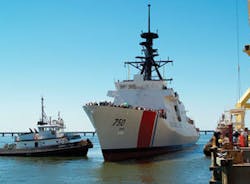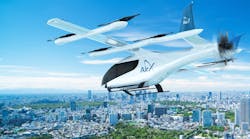By John McHale
WASHINGTON - Nearly half a decade old, the U.S. Department of Homeland Security (DHS) is showing moderate growth in its budget request, while funding for research and development focuses on more solutions for today than for programs 20 years in the future.
DHS Officials requested 8 percent more money overall in their 2008 budget request, with research and development focused on providing solutions for current needs. The total budget request is $46.4 billion. Federal fiscal year 2008 starts Oct. 1.
The homeland-security market is fragmented and less dynamic today, which can be frustrating from a general procurement perspective, says Gerald Buckwalter, vice president of homeland security for Northrop Grumman Corp. in McLean, Va. However, the future holds “reasonable to moderate growth.” DHS does not have the infrastructure to manage aggressive growth; it is still too new, he adds.
DHS executives are also reorganizing the department to support the research and funding activities of the other DHS arms, “except nuclear and biochem detection,” Buckwalter says.
DHS officials are seeking an increase of $47.4 million for the Acceleration of Next-Generation Research and Development program, which would increase spending across several research, development, and operations program areas.
HSARPA (Homeland Security Advanced Research Projects Agency) is still part of that arm, but unlike DARPA (the U.S. Defense Advance Research Projects Agency) it does research and development for use today, as opposed to decades down the road, Buckwalter says. It is also separate from DAPRA unlike it may have been at the beginning. It will serve the entire community and will still have money for its own little innovations, he adds.
There is some growth at the federal level for DHS “but most of the growth is at the state and local level,” Buckwalter says. When DHS first came on the scene it was a top-down approach with the federal government expected to provide all the money.
“Well it’s changing and the local communities and states are realizing that if they are sitting around waiting for federal grants they will probably never see them,” Buckwalter says. “They need to aggressively pursue the programs themselves. They’re realizing homeland security begins close to home”-and they are gaining the political will to do what they need to do for their communities.
New York City’s broadband wireless public-safety network, provided by Northrop Grumman, is an example of a local community solving its own security issues, albeit on a much larger scale, Buckwalter says.
There are unique programs that only the federal government can do, such as border security, aircraft missile defense, Coast Guard applications, etc., but there needs to be more of a balance between the federal government and state and local communities.
The industry models have also evolved since DHS first came on the scene, with prime contractors realizing that doing business with DHS is much different from doing business with the Department of Defense (DOD).
“Public safety is a different concept than managing warfare,” he says. There are many constraints and limitations, and public will is involved-“that’s why technology transfer doesn’t always work from DOD to DHS.” The technology is fine, it is the policies and procedures, congress, etc., that get in the way. There is pretty much a COTS (commercial-off-the-shelf) mindset all the way now; it is just a matter of how to manage costs, he adds.
The culture is different in civilian space, Buckwalter continues. The military is more hierarchical with one person in charge, while in civil space you could have 20 people in charge like during Katrina. “They don’t define the system the same as military.”
Also, for example, a camera that does not fail yet has several false alarms might be OK for the DOD because it wants it to detect everything, but in civil space false alarms are anathema because of lawsuits and continuance of government. “You cannot evacuate a port or airport over every false alarm rate,” Buckwalter says.
Buckwalter notes that DHS “won’t ever recede because the level of constant reminders will be ever present-Virginia Tech., Fort Dix, Hurricanes, etc.,” he says. “We have freedoms in this country so it comes down to a balance of managing risk.” Like when you decide what your insurance deductible will be. “You choose the amount based on how much the likelihood is that you will need the insurance money.”
Notable DHS budget requests
One of the big-ticket items in the DHS budget request is $1 billion to support the SBInet program deployment and create an integrated infrastructure and technology solution for effective control of the border that includes fencing and virtual barriers to prevent illegal entry into the U.S.
Regarding identity tracking an increase of $146.2 million was requested for the Unique Identity initiative, which would establish the foundational capabilities to improve identity establishment and verification with the transition to 10-Print and Automated Biometric Identification System (IDENT) and Integrated Automated Fingerprint Identification System (IAFIS) interoperability. The money would provide the capability to biometrically screen foreign visitors requesting entry to the U.S. through the collection of 10-print capture, rather than the current two, at enrollment, DHS officials say. US-VISIT, along with the departments of State and Justice, would be able to continue efforts to develop interoperability between DHS’ IDENT and Justice’s IAFIS systems.
An increase of $224.2 million is requested to support the Transportation Security Administration’s screening operations. This includes procurement and installation of checkpoint support and explosives detection systems.
DHS officials are also looking for an increase of $38 million to support development and initial operating capability for the Secure Flight system. This includes money for hardware procurement, operations ramp-up and training, and network interface engineering between the Secure Flight and U.S. Customs and Border Protection (CBP) Advanced Passenger Information System (APIS) network. Secure Flight will strengthen watch-list screening and vet all domestic air travelers.
The Coast Guard’s Integrated Deepwater System is getting a hefty increase of $788.1 million in the budget request. This money would complete the acquisition of four National Security Cutters, fund engineering and design costs for the Replacement Patrol Boat, and purchase four additional Maritime Patrol Aircraft. DHS officials say these long-awaited upgrades to its fleet would strengthen the Coast Guard’s ability to safeguard seaports from terrorists seeking to enter the country or transport dangerous weapons or materials.
Cargo security is also getting attention in the 2008 budget request. Funding of $178 million would provide for the procurement and deployment of radiation portal monitors, including next-generation advanced spectroscopic portal systems. The requested resources would help achieve the goal of screening 98 percent of all containers entering the U.S. by the end of FY 2008.
An increase of $15 million is requested for the Secure Freight Initiative, which is designed to maximize radiological and nuclear screening of U.S.-bound containers from foreign ports. Secure Freight includes a next-generation risk-assessment screening program and an overseas detection network, while merging existing and new information regarding containers transiting through the supply chain.




